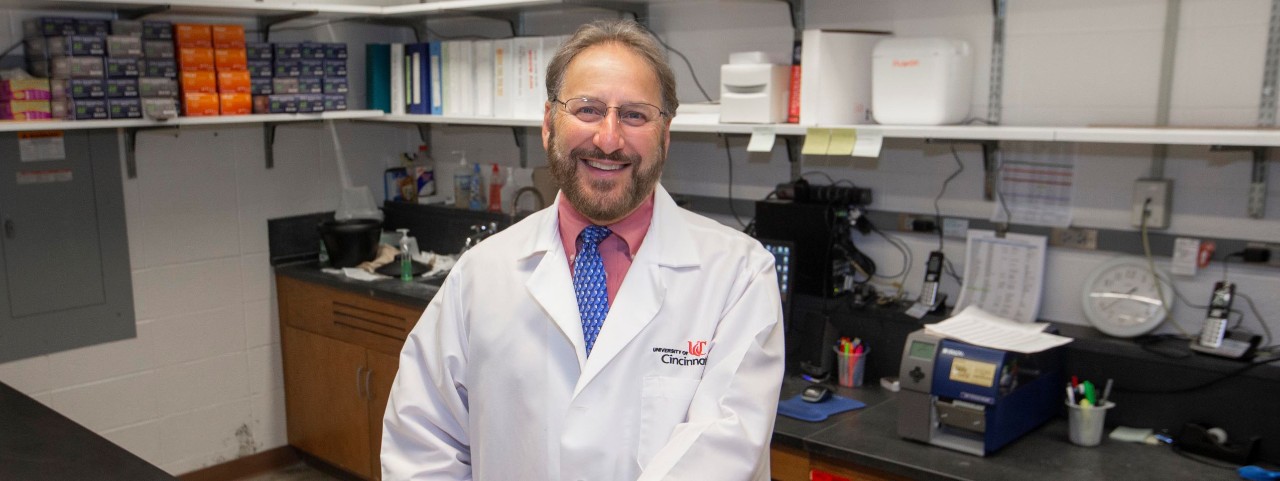
UC researcher collaborates in gene-editing study in HIV patients
Study could help lead to the discovery of cure for HIV
Researchers at the University of Cincinnati (UC) are collaborating in a study that will pinpoint and alter a specific gene in people with HIV. The hope is that process will lower the amount of HIV in the person’s body, and could possibly lead to the development of a cure for HIV.
By targeting the C-C motif chemokine receptor (CCR5) gene, Carl Fichtenbaum, MD, professor in the Division of Infectious Diseases in the Department of Internal Medicine at the UC College of Medicine, and a principal investigator on the study, and his colleagues at Case Western Reserve University (CWRU), will modify that gene creating a mutation that prohibits the entry of HIV into specific white blood cells called lymphocytes.
“On the surface of lymphocytes, which are the cells that are mainly infected by HIV, there is a receptor,” Fichtenbaum says. “Think of it like a lock to a door and HIV as a key. HIV has a little protein that juts out and that fits right into the lock of that CCR5 receptor. People who are born without that receptor cannot be infected with HIV. People who are born with only half of them seem to suffer less ill effects from HIV.”
Known as the TRAILBLAZER study, or “T-Cell Reinfusion After Interfering With Lymphocyte Binding Location of AIDS Virus Through Zinc-finger-nuclease Elimination of CCR5 Receptors” UC researchers will collaborate with CWRU in Cleveland and the University of California-San Francisco (UCSF). Most of the 30 patients in the study will be enrolled this year and next year and researchers will follow them for two years.
“The CCR5 gene is critical for sustaining HIV infection in humans,” says Fichtenbaum. “In this study, we are going to remove white blood cells from people who are infected, sort out their lymphocytes and about two-thirds of the people are going to get them modified. The CCR5 gene will be removed using zinc finger nucleases technology.”
Fichtenbaum says the zinc finger nucleases technology is a virus developed by scientists that is called a vector. That vector is inserted into a nuclease, which is an enzyme that cuts like scissors.
“You put a little homing device on that vector and instruct it to cut out the CCR5 gene,” Fichtenbaum says. “That homing device snips on either side of the gene and creates a hole that is then repaired by a technology called end-joining, where the two ends are joined back together using a different enzyme. It’s a normal, natural DNA-repair enzyme that happens all the time in our body.”
Fichtenbaum says the object of putting the cells back in the subject is to see if this lowers the amount of HIV that remains, which is called their HIV reservoir.
“We will compare the group of people who have their cells taken out and modified with the group of people who have their cells taken out but not modified,” says Fichtenbaum. “That will tell us how much this effects the HIV reservoir and if it starts to lower the reservoir, then we know we’re on the right track. Lowering that reservoir is the key to trying to cure people.”
In addition to the collaboration with CWRU and UCSF, Fichtenbaum says there are several joint efforts on a local level. People enrolled in the study will have their infusions and procedures done at the Schubert Research Center at Cincinnati Children’s. Hoxworth Blood Center is involved by providing leukapheresis, a laboratory procedure in which white blood cells are separated from a sample of blood.
“It’s a multi-collaborative study with a lot of researchers involved where we’re going to learn from a lot of people, including the Division of Digestive Diseases and the Department of Surgery.”
Fichtenbaum says while this type of gene-editing procedure has been done before in individuals, the research has not been done in a controlled study of this size and this nature.
“If we can show that this will decrease the reservoir of HIV throughout the body, then we may be taking the first baby steps towards developing a method for a cure of HIV,”says Fichtenbaum. “What I’m really hoping for is that we will have participants on the study who are willing to, as I explain it to them, be some of the first people to circle the globe. Before we could get to the moon, we had to go around the earth. We had to have some people who would take that step.”
The nearly $11 million in funding was provided by the National Institutes of Health, primarily through the National Institute of Allergy and Infectious Diseases for grant NCT03666871.
Feature photo: Joseph Fuqua II/UC Creative Services
Additional Contacts
Related Stories
UC researcher develops at-home diagnostic test for endometriosis
April 21, 2025
Katherine Burns, a University of Cincinnati researcher who has endometriosis, speaks about her journey of developing a non-invasive diagnostic test for the condition.
NEXT Innovation Scholar Charlie Harker
April 21, 2025
From strategizing with community leaders on the future of transportation solutions to collaborating with global corporate partners to dive into complex consumer insights, the NEXT Innovation Scholars (NIS) program at the University of Cincinnati empowers a new generation of leaders and problem solvers.
Music as Medicine: World Voice Day shines a light on healing...
April 18, 2025
On April 16, 2025, voices filled Cincinnati Music Hall — not just with song, but with purpose, for World Voice Day: Music as Medicine — a vibrant celebration of the healing power of voice and music.
